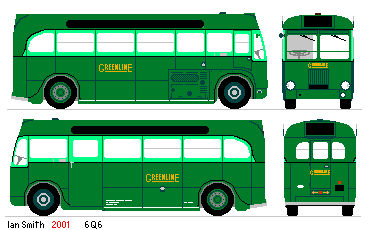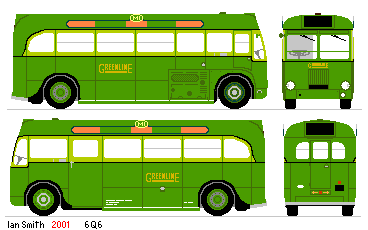
The LONDON TRANSPORT AEC Q classThis page created 4th January 2001, updated 23rd January 2005, using Notepad, by Ian Smith.The 6Q6The Q was available in coach form, and various long low sleek versions plied their trade around the country. But GreenLine wasn't quite normal coaching, and London Transport did its own thing - as usual - with the 6Q6 for GreenLine use.ConstructionChassis: AEC Q, 18ft 6in wheelbase, AEC A170 oil engineBody: Park Royal, 27ft 6in, C33C.
Into serviceThe 6Q6s went to Hertford (HG), Guildford (GF) and Addlestone (WY) for the M group, to Luton (LS) for the H3, to High Wycombe (HE) and Amersham (MA) for the Q and R.
Wartime: ambulancesThe outbreak of war in September 1939 saw the suspension of the Green Line services and the requisition of all the 6Q6s as public-service ambulances. They acquired wartime garb, with white corners, brown roofs and ant-shatter netting. The headlights posed a problem. with their integral sidelights. They were replaced by dual units, with hooded miniature headlight mounted next to a reduced sidelight holder within the original headlamp mounting.They were allocated to several garages, notably Chalk Farm, for use carrying air-raid victims and for ferrying wounded troops from stations to hospitals. Q217 was destroyed in the cruise missile attack on Elmers End garage in July 1944. Between 1944 and 1946 the ambulances were overhauled and returned to Green Line condition, some in Lincoln green and white livery, for the resumption of Green Line services from March 1946 onwards. Post-war Green Line March 1946 saw some allocated to Godstone (GD) for the 709,
Crawley for the 710 and Reigate for the 711.
March 1946 saw some allocated to Godstone (GD) for the 709,
Crawley for the 710 and Reigate for the 711.
April saw others return to High Wycombe and Amersham for the 724 and 725. But in June the southern allocations were exchanged for 10T10s, the 6Q6s going to Hertford and Guildford again, for the 715. There was a period of stability, then in November 1947 the Amersham and High Wycombe allocations were made redundant when the 709/710/711 were linked across London to the 724/725. 10T10s were used on all the branches. The 6Q6s went to St Albans for bus work and as relief Green Lines.
Their post-war operations on GreenLine work came to an end with the introduction of the coach RFs. They were not the first to be replaced: 10T10s were needed for cascade to Central Area bus duties. But in December 1951 and January 1952 Hertford and Guildford had their 6Q6s replaced by RFs. The 6Q6s, which had been run down to withdrawal, were placed in store pending sale for scrap. Resurrection: The Muswell Hill interludeBut the Trades Unions had other ideas. The busy 210 route in hilly north London was still using twenty-year-old petrol-engined "scooters" (LTLs), and the crews had been promised replacements as soon as possible. When they saw the 6Q6s going for scrap they asked to have them as an interim measure until the Central RFs came along. For once London Transport acceded to a shop-floor idea, and in March 1952 the best twenty-four were allocated to Muswell Hill for the 210 and the 244, displacing the elderly six-wheelers.
They were not repainted, but went into service in their post-war GreenLine livery, but with London Transport fleetnames replacing the GreenLine transfers (in most cases). But Muswell Hill was due to receive the first Central Area RFs, and these began to arrive in September 1952, spelling the end for the 6Q6s. They were dispatched to Edgware for storage pending sale for scrap.
|
 It had a high floor, like the 5Q5,
to give level seating without significant wheel-arch intrusion,
and a high level roof that still didn't avoid a slightly claustrophobic sense in the interior.
Thirty three deep-cushioned seats provided for the longer distance urban passenger,
and a hydraulically powered central door avoided the howling gale of the 5Q5.
The front styling was a little more staid than the 5Q5,
with ventilator flaps set above the wind-screen,
which was lower than on the 5Q5.
The front quarters had deep windows that scooped down to windscreen base level.
A grille for the saloon heater air intake graced the front.
The large headlamps
followed the fashion of the 9T9 Regals, with included sidelights.
A direction/stop indicator was mounted under the rear emergency door.
It had a high floor, like the 5Q5,
to give level seating without significant wheel-arch intrusion,
and a high level roof that still didn't avoid a slightly claustrophobic sense in the interior.
Thirty three deep-cushioned seats provided for the longer distance urban passenger,
and a hydraulically powered central door avoided the howling gale of the 5Q5.
The front styling was a little more staid than the 5Q5,
with ventilator flaps set above the wind-screen,
which was lower than on the 5Q5.
The front quarters had deep windows that scooped down to windscreen base level.
A grille for the saloon heater air intake graced the front.
The large headlamps
followed the fashion of the 9T9 Regals, with included sidelights.
A direction/stop indicator was mounted under the rear emergency door.
 bus histories
bus histories Bus Stop
Bus Stop Q index.
Q index. 5Q5
5Q5 6Q6
6Q6